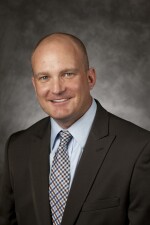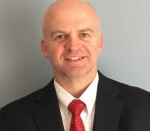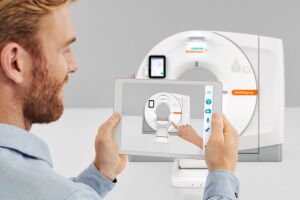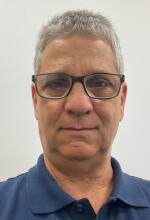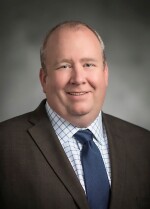How the coronavirus has impacted OEM service
August 31, 2020
by Lisa Chamoff, Contributing Reporter
As the coronavirus pandemic has shifted hospital priorities and slowed the case volume at some imaging centers, equipment manufacturers have also had to respond by making changes to their service offerings.
OEMs are pivoting to virtual training and assistance and promoting the use of remote monitoring to predict and prevent outages. At the same time, they’re making sure their technicians, now more than ever, adhere to strict infection-control standards.
Virtual classrooms
Just as the pandemic has pushed more companies to embrace working from home, it has also accelerated quicker adoption of virtual support and training.
For Siemens Healthineers, this meant bringing a product to market sooner than anticipated.
The company was in the process of developing SmartCollaborator, which would allow its technical support team in North Carolina to provide support to customers over their mobile devices.
“It allows us to augment the view,” explained Matthew McCallum, vice president of business management and marketing for customer services at Siemens Healthineers. “As they hold their smart device over a circuit board or panel of switches, the technical support team can use an artificial finger to circle and point to things.”
The technology was in the process of being adopted internally by Siemens Healthineers’ own engineers and they were discussing how customers might use it. When the pandemic hit, they decided to start offering SmartCollaborator to clinical engineers.
“We quickly realized when it happened we had to change our go-to-market strategy,” McCallum said. “It’s a way for us to provide very direct and hands-on support to customers.”
The company has also seen an increase in demand for virtual training content.
Dräger, which manufactures patient monitors, ventilators and anesthesia machines used for long term ventilation, all key equipment when treating patients with COVID-19, has been in a unique position when it comes to service.
While preventive maintenance, repair services and training on equipment such as ventilators requires a hands-on component, and migrating to online training has proved to be challenging, the company has joined forces with other global ventilator manufacturers to form a Ventilator Training Alliance (VTA) and has launched a remote anesthesia clinician support with Intensive Care On-line Network, said David Karchner, senior director of marketing in North America for operating room solutions, enterprise monitoring solutions and enterprise services for Dräger.
"Our Dräger Training Academy has implemented a new process based on the Centers for Disease Control and Prevention guidelines in order to protect our students and trainers when visiting our Telford facility," Karchner said. "With that said, we have just recently invested in local dedicated staff to focus exclusively on expanding our digital training capability."
Philips is also transitioning to more virtual training solutions, after suspending operations of its training facilities in March due to the COVID crisis, adding nearly 1,600 additional virtual training opportunities as of June.
"A significant number of courses have migrated from on-site instructor-led to virtual instructor-led," said Rob Stevens, service operations leader for services and solutions delivery for Philips North America. "The virtual clinical events are live and cover equipment essentials, configurations and go-live support, as well as advanced learnings. We have also ramped up to deliver more webinars. The webinar series complements the live events and provides education and insights for a variety of topics, both COVID-19 and non-COVID-19 related."
The rise of remote monitoring
Manufacturers have long promoted remote monitoring of equipment, and the pandemic has made the technology even more attractive.
“Our first course of action, no matter what, is to try to solve the problem remotely,” said Richard L. Fiore, director of U.S. and Canada service and service sales for Carestream. “We can dial into our equipment to observe settings and critical parameters of operation. If we cannot solve the problem remotely, then more often than not, we are able to obtain a solid diagnosis for the field engineer. This knowledge will equip the field engineer with important information to ensure a timely and efficient customer workflow recovery.”
GE Healthcare saw more demand for remote monitoring and diagnostic capabilities, such as its OnWatch and Tube Watch predictive analytics technologies, and more usage of its iCenter cloud-based asset maintenance and management software tool, said Todd Brown, the U.S. and Canada service leader for GE Healthcare.
The company has also seen greater demand for the online and virtual training opportunities it had already offered.
“The push for remote training has definitely accelerated,” Brown said.
Siemens Healthineers offers a suite of remote tools, including one in which technicians can take over the operation of a device and do some basic troubleshooting.
"We do not scan patients remotely, but we can help with image processing and image quality troubleshooting," McCallum said.
The company's Guardian remote monitoring tool measures CT tube current, cooling flow, and cooling capabilities, providing an early warning when something is not working correctly to help facilities mitigate the damage.
Siemens Healthineers has even begun to make guarantees on its prediction of failure.
"If a tube fails and we didn't predict it, we refund the money for remote monitoring," McCallum said.
Philips is taking the opportunity to actively enhance its remote capabilities.
"At our Customer Care Solutions Center in Atlanta, Georgia, we are increasing and improving our connections to systems via our Philips Remote Services (PRS) secured internet connection," Stevens said. "Connected systems can 'phone home' to alert remote engineers that a system may be experiencing an issue that is not visible to the operator. In these cases, we can proactively initiate service to improve system performance. Our remote capabilities continue to evolve as a means of collaboration with our field teams and our customers."
Safety first
When working in facilities battling a highly infectious disease, manufacturers have had to ensure that their technicians adhere to strict infection control protocols.
Fiore of Carestream said when the virus first emerged in China, the company immediately began making sure an adequate supply of masks, gloves, shields, and suits were available for customer-facing service personnel in the U.S. and Canada.
Carestream field engineers also contact customers before visits to check if there are any special protocols beyond face masks and gloves. Some facilities, particularly in hotspots, added questionnaires and temperature checks.
“We have to be cognizant of their protocols and how they're doing things,” Fiore said. “It just underscores the need to be aware of everything.”
McCallum of Siemens Healthineers said some facilities have required technicians to test for COVID-19 before coming in.
Brown said that while GE already had solid infection control protocols in place, they had to rethink things that require a physical signature from customers and make sure to secure the appropriate electronic signature and documentation.
Dräger has had to implement special protocols to avoid contamination when testing and servicing ventilators.
"When going on site, the use of personal protective equipment is obviously a must in order to protect employees, customers and patients," Karchner said. "Additionally, we had to design new filtering setups to protect our test equipment for the rare instances when cross-contamination could not be ruled out."
A break in routine
While service providers did see a change in what customers wanted for service during the pandemic, it varied.
Some of Carestream’s customers delayed regular service activities.
“Their focus was on critical service situations or new installations,” said Fiore, who noted that as the pandemic progressed, more hospitals began opening up for preventative maintenance, upgrades and other non-critical service needs.
Suresh Narayan, director of installed base programs in the service division of Canon Medical Systems USA, said that during the earlier part of the pandemic, customers suspended system upgrades and major changes to their systems, and focused on preventive maintenance with short visits and minimal physical contact with workers.
“They just wanted to keep their systems running,” Narayan said. “We adapted to what the customers’ needs were at that point in time.”
Canon Medical technicians made sure the visits were short and to the point.
“We ensured our customers got their preventive maintenance, but we had minimal physical contact with people in the facility,” Narayan said.
Some companies were already shifting how they do business before the pandemic.
Earlier this year, Siemens Healthineers introduced a new service offering called CentriCare, which allows customers to select a preferred time for non-urgent service requests so that they don't disrupt patient care.
“We've found that 60 to 70% of calls we get during the day don't have to be resolved during the day," McCallum said. "This is forcing us to do more of the work after hours. As elective cases come back we expect utilization and throughput to actually exceed what it was prior to the pandemic."
While it’s easy to assume that the pandemic would cause a shift to in-house service, Narayan of Canon Medical said the trend is continuing as it had pre-pandemic.
"Large IDNs want to develop their own biomed or clinical engineering groups to do the first level of service," Narayan said. "Generally, what happens is there are 10-, 12- or 15-year-old systems [and] that's what clinical biomeds take care of. The newer systems — seven or eight years and newer — they would like the OEMs to service their systems. That trend has not really changed because of COVID."
Companies expect to continue balancing the needs of all customers, whether they are clinicians or in-house service teams.
Karchner of Dräger said the company has always been interested in supporting its customers’ service strategy, regardless of who performs the service.
“While many vendors have separate classes for customers versus their own service teams, with Dräger they sit in the same classroom and learn how to service Dräger equipment together,” Karchner said. “It’s a differentiator for us, and it’s one that we’re very proud of.”
OEMs are pivoting to virtual training and assistance and promoting the use of remote monitoring to predict and prevent outages. At the same time, they’re making sure their technicians, now more than ever, adhere to strict infection-control standards.
Virtual classrooms
Just as the pandemic has pushed more companies to embrace working from home, it has also accelerated quicker adoption of virtual support and training.
For Siemens Healthineers, this meant bringing a product to market sooner than anticipated.
The company was in the process of developing SmartCollaborator, which would allow its technical support team in North Carolina to provide support to customers over their mobile devices.
“It allows us to augment the view,” explained Matthew McCallum, vice president of business management and marketing for customer services at Siemens Healthineers. “As they hold their smart device over a circuit board or panel of switches, the technical support team can use an artificial finger to circle and point to things.”
The technology was in the process of being adopted internally by Siemens Healthineers’ own engineers and they were discussing how customers might use it. When the pandemic hit, they decided to start offering SmartCollaborator to clinical engineers.
“We quickly realized when it happened we had to change our go-to-market strategy,” McCallum said. “It’s a way for us to provide very direct and hands-on support to customers.”
The company has also seen an increase in demand for virtual training content.
Dräger, which manufactures patient monitors, ventilators and anesthesia machines used for long term ventilation, all key equipment when treating patients with COVID-19, has been in a unique position when it comes to service.
While preventive maintenance, repair services and training on equipment such as ventilators requires a hands-on component, and migrating to online training has proved to be challenging, the company has joined forces with other global ventilator manufacturers to form a Ventilator Training Alliance (VTA) and has launched a remote anesthesia clinician support with Intensive Care On-line Network, said David Karchner, senior director of marketing in North America for operating room solutions, enterprise monitoring solutions and enterprise services for Dräger.
"Our Dräger Training Academy has implemented a new process based on the Centers for Disease Control and Prevention guidelines in order to protect our students and trainers when visiting our Telford facility," Karchner said. "With that said, we have just recently invested in local dedicated staff to focus exclusively on expanding our digital training capability."
Philips is also transitioning to more virtual training solutions, after suspending operations of its training facilities in March due to the COVID crisis, adding nearly 1,600 additional virtual training opportunities as of June.
Ventilator systems like the Dräger V500 have been critical in the fight against COVID-19. Photo courtesy: Draeger
The rise of remote monitoring
Manufacturers have long promoted remote monitoring of equipment, and the pandemic has made the technology even more attractive.
“Our first course of action, no matter what, is to try to solve the problem remotely,” said Richard L. Fiore, director of U.S. and Canada service and service sales for Carestream. “We can dial into our equipment to observe settings and critical parameters of operation. If we cannot solve the problem remotely, then more often than not, we are able to obtain a solid diagnosis for the field engineer. This knowledge will equip the field engineer with important information to ensure a timely and efficient customer workflow recovery.”
GE Healthcare saw more demand for remote monitoring and diagnostic capabilities, such as its OnWatch and Tube Watch predictive analytics technologies, and more usage of its iCenter cloud-based asset maintenance and management software tool, said Todd Brown, the U.S. and Canada service leader for GE Healthcare.
The company has also seen greater demand for the online and virtual training opportunities it had already offered.
“The push for remote training has definitely accelerated,” Brown said.
With SmartCollaborator, the Siemens Healthineers technical support team can coordinate with on-site clinical engineers. Photo courtesy: Siemens Healthineers
"We do not scan patients remotely, but we can help with image processing and image quality troubleshooting," McCallum said.
The company's Guardian remote monitoring tool measures CT tube current, cooling flow, and cooling capabilities, providing an early warning when something is not working correctly to help facilities mitigate the damage.
Siemens Healthineers has even begun to make guarantees on its prediction of failure.
"If a tube fails and we didn't predict it, we refund the money for remote monitoring," McCallum said.
Philips is taking the opportunity to actively enhance its remote capabilities.
"At our Customer Care Solutions Center in Atlanta, Georgia, we are increasing and improving our connections to systems via our Philips Remote Services (PRS) secured internet connection," Stevens said. "Connected systems can 'phone home' to alert remote engineers that a system may be experiencing an issue that is not visible to the operator. In these cases, we can proactively initiate service to improve system performance. Our remote capabilities continue to evolve as a means of collaboration with our field teams and our customers."
Safety first
When working in facilities battling a highly infectious disease, manufacturers have had to ensure that their technicians adhere to strict infection control protocols.
Fiore of Carestream said when the virus first emerged in China, the company immediately began making sure an adequate supply of masks, gloves, shields, and suits were available for customer-facing service personnel in the U.S. and Canada.
Carestream field engineers also contact customers before visits to check if there are any special protocols beyond face masks and gloves. Some facilities, particularly in hotspots, added questionnaires and temperature checks.
“We have to be cognizant of their protocols and how they're doing things,” Fiore said. “It just underscores the need to be aware of everything.”
McCallum of Siemens Healthineers said some facilities have required technicians to test for COVID-19 before coming in.
Brown said that while GE already had solid infection control protocols in place, they had to rethink things that require a physical signature from customers and make sure to secure the appropriate electronic signature and documentation.
Dräger has had to implement special protocols to avoid contamination when testing and servicing ventilators.
"When going on site, the use of personal protective equipment is obviously a must in order to protect employees, customers and patients," Karchner said. "Additionally, we had to design new filtering setups to protect our test equipment for the rare instances when cross-contamination could not be ruled out."
A break in routine
While service providers did see a change in what customers wanted for service during the pandemic, it varied.
Some of Carestream’s customers delayed regular service activities.
“Their focus was on critical service situations or new installations,” said Fiore, who noted that as the pandemic progressed, more hospitals began opening up for preventative maintenance, upgrades and other non-critical service needs.
Suresh Narayan, director of installed base programs in the service division of Canon Medical Systems USA, said that during the earlier part of the pandemic, customers suspended system upgrades and major changes to their systems, and focused on preventive maintenance with short visits and minimal physical contact with workers.
“They just wanted to keep their systems running,” Narayan said. “We adapted to what the customers’ needs were at that point in time.”
Canon Medical technicians made sure the visits were short and to the point.
“We ensured our customers got their preventive maintenance, but we had minimal physical contact with people in the facility,” Narayan said.
Some companies were already shifting how they do business before the pandemic.
Earlier this year, Siemens Healthineers introduced a new service offering called CentriCare, which allows customers to select a preferred time for non-urgent service requests so that they don't disrupt patient care.
“We've found that 60 to 70% of calls we get during the day don't have to be resolved during the day," McCallum said. "This is forcing us to do more of the work after hours. As elective cases come back we expect utilization and throughput to actually exceed what it was prior to the pandemic."
While it’s easy to assume that the pandemic would cause a shift to in-house service, Narayan of Canon Medical said the trend is continuing as it had pre-pandemic.
"Large IDNs want to develop their own biomed or clinical engineering groups to do the first level of service," Narayan said. "Generally, what happens is there are 10-, 12- or 15-year-old systems [and] that's what clinical biomeds take care of. The newer systems — seven or eight years and newer — they would like the OEMs to service their systems. That trend has not really changed because of COVID."
Companies expect to continue balancing the needs of all customers, whether they are clinicians or in-house service teams.
Karchner of Dräger said the company has always been interested in supporting its customers’ service strategy, regardless of who performs the service.
“While many vendors have separate classes for customers versus their own service teams, with Dräger they sit in the same classroom and learn how to service Dräger equipment together,” Karchner said. “It’s a differentiator for us, and it’s one that we’re very proud of.”

